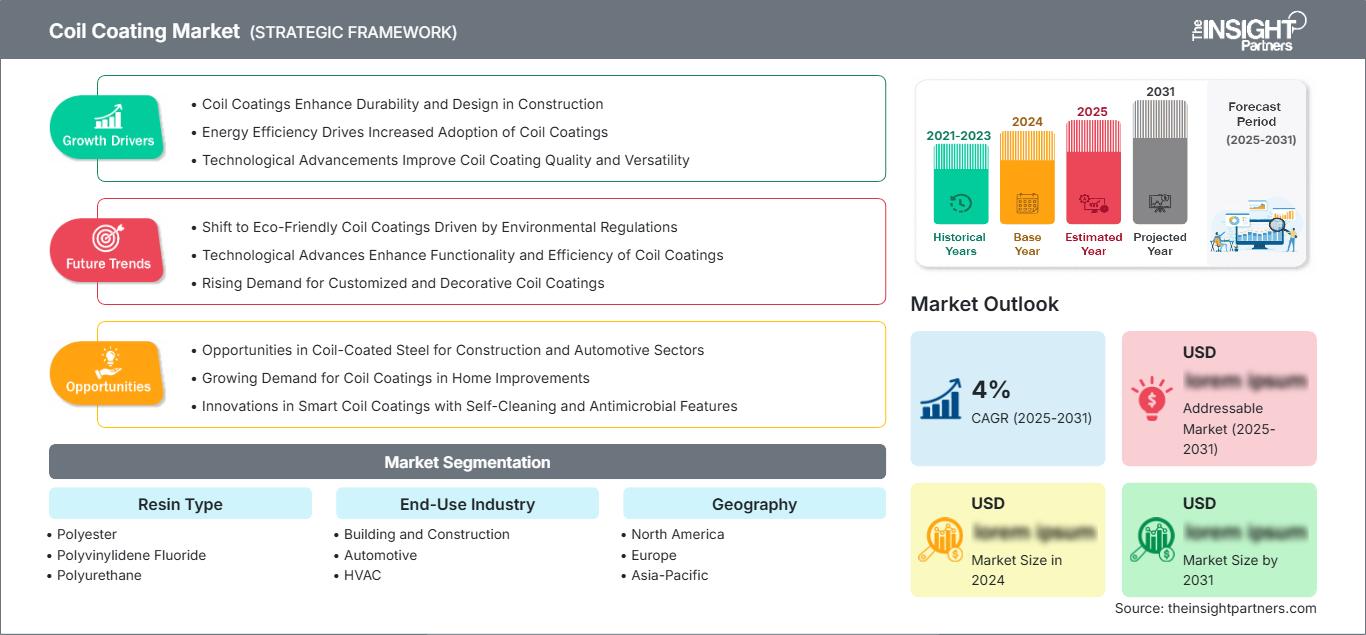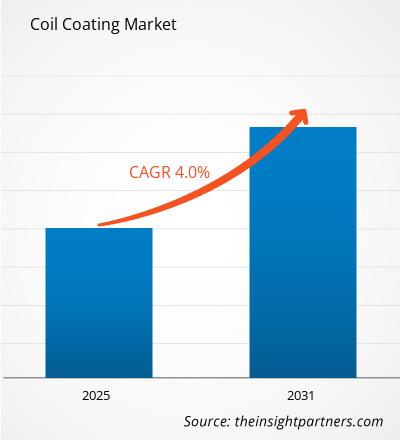Si prevede che il mercato del coil coating registrerà un CAGR del 4% dal 2025 al 2031, con una dimensione del mercato in espansione da XX milioni di dollari nel 2024 a XX milioni di dollari entro il 2031.
Il rapporto è segmentato per tipo di resina (poliestere, fluoruro di polivinilidene (PVDF), poliuretano (PU), plastisol e altri). Il rapporto è inoltre segmentato per settore di utilizzo finale (edilizia e costruzioni, automotive, HVAC, elettrodomestici industriali e domestici, arredamento e altri). L'ambito del rapporto copre 5 regioni: Nord America, Europa, Asia-Pacifico, Medio Oriente e Africa, America meridionale e centrale e i paesi chiave di ciascuna regione. L'analisi globale è ulteriormente suddivisa a livello regionale e per paesi principali. Il rapporto offre il valore in USD per l'analisi e i segmenti sopra indicati.
Scopo del rapporto
Il rapporto Coil Coating Market di The Insight Partners mira a descrivere il panorama attuale e la crescita futura, i principali fattori trainanti, le sfide e le opportunità. Ciò fornirà spunti a vari stakeholder aziendali, come:
- Fornitori/produttori di tecnologia: per comprendere le dinamiche di mercato in evoluzione e conoscere le potenziali opportunità di crescita, consentendo loro di prendere decisioni strategiche informate.
- Investitori: per condurre un'analisi completa delle tendenze in merito al tasso di crescita del mercato, alle proiezioni finanziarie di mercato e alle opportunità esistenti lungo la catena del valore.
- Enti di regolamentazione: per regolamentare le politiche e le attività di controllo sul mercato con l'obiettivo di ridurre al minimo gli abusi, preservare la fiducia degli investitori e sostenere l'integrità e la stabilità del mercato.
Segmentazione del mercato del rivestimento a bobina Tipo di resina
- Poliestere
- Fluoruro di polivinilidene
- Poliuretano
- Plastisol
Settore di utilizzo finale
- Edilizia e costruzioni
- Automotive
- HVAC
- Elettrodomestici industriali e domestici
- Arredamento
Potrai personalizzare gratuitamente qualsiasi rapporto, comprese parti di questo rapporto, o analisi a livello di paese, pacchetto dati Excel, oltre a usufruire di grandi offerte e sconti per start-up e università
Mercato del rivestimento a bobina: Approfondimenti strategici

-
Ottieni le principali tendenze chiave del mercato di questo rapporto.Questo campione GRATUITO includerà l'analisi dei dati, che vanno dalle tendenze di mercato alle stime e alle previsioni.
Fattori di crescita del mercato del coil coating
- I coil coating migliorano la durata e il design nell'edilizia: i cambiamenti climatici e altri fattori hanno portato a un crescente interesse in diversi settori. Uno dei settori che ha registrato una crescita straordinaria è il coil coating, che a sua volta ha molti fattori che contribuiscono alla sua crescita. L'industria edile utilizza coil coating che prevengono i raggi UV e migliorano il design e la durata degli edifici. Le moderne tecniche di costruzione si concentrano sull'arte della costruzione, sui materiali utilizzati e sulla durata di questi edifici, da qui l'uso dei coil coating.
- L'efficienza energetica favorisce una maggiore adozione dei coil coating: poiché l'efficienza energetica è diventata un obiettivo primario, i coil coating vengono adottati sempre di più grazie alla loro capacità di migliorare l'isolamento termico, riducendo così al minimo il consumo energetico negli edifici. Ciò è in linea con i programmi di sostenibilità a livello mondiale e, di conseguenza, spinge i produttori a optare per sistemi di coil coating più sofisticati.
- I progressi tecnologici migliorano la qualità e la versatilità del coil coating: i progressi tecnologici delle attrezzature per il coil coating, ad esempio migliorando le formulazioni e altre tecniche di applicazione, stanno migliorando la qualità dei prodotti. Questi miglioramenti garantiscono una maggiore durata, resistenza alla corrosione e un'elevata ecocompatibilità dei coil coating, rendendoli adatti all'uso in settori diversi da quello edile e delle costruzioni, come l'industria automobilistica e degli elettrodomestici.
Tendenze future del mercato del coil coating
- Passo a coil coating ecocompatibili guidato dalle normative ambientali: negli ultimi anni si è assistito a un significativo passaggio a coil coating ecocompatibili, dovuto a normative ambientali più severe e alla richiesta da parte dei consumatori di prodotti più ecocompatibili. Sempre più produttori stanno introducendo rivestimenti a basso contenuto di COV e a base acqua che contribuiscono a mitigare l'impatto ambientale, garantendo al contempo prestazioni e durata in diversi campi di applicazione.
- I progressi tecnologici migliorano la funzionalità e l'efficienza dei coil coating: alcuni progressi nelle tecnologie di coil coating stanno migliorando la funzionalità del prodotto e l'efficienza operativa. Gli sviluppi logici hanno portato al recupero delle caratteristiche adesive e di protezione dalla corrosione, nonché alle loro caratteristiche decorative; pertanto, il coil coating è più interessante per molti settori, in particolare l'edilizia e l'automobile, che ne fanno un ampio utilizzo.
- Crescente domanda di coil coating personalizzati e decorativi: la tendenza verso finiture personalizzate e decorative è in aumento, soprattutto nel settore dell'edilizia e degli elettrodomestici. I coil coating sono in fase di sviluppo, consentendo combinazioni di colori e texture specifiche per adattarsi al design richiesto di un determinato prodotto, migliorandone l'estetica complessiva.
Opportunità di mercato per il coil coating
- Opportunità per l'acciaio preverniciato per i settori edile e automobilistico: con i settori edile e automobilistico alla ricerca di materiali più leggeri e più efficienti dal punto di vista energetico, esiste un'opportunità redditizia. L'acciaio preverniciato è sia resistente che decorativo, il che lo rende adatto all'architettura contemporanea e alla produzione di veicoli, che a loro volta ne stanno scegliendo il mercato.
- Crescente domanda di coil coating nelle ristrutturazioni domestiche: il crescente interesse per le ristrutturazioni edilizie sta determinando un aumento della domanda di coil coating. Man mano che le persone migliorano le proprie abitazioni con rivestimenti specifici, un coil coating è un prodotto adatto in quanto aggiunge valore sia all'utilizzo del rivestimento nell'edificio sia all'aspetto dell'edificio stesso.
- Innovazioni nei coil coating intelligenti con caratteristiche autopulenti e antimicrobiche: i progressi compiuti nella creazione di coil coating intelligenti con caratteristiche autopulenti e antimicrobiche offrono un'entusiasmante opportunità. Questi rivestimenti ad alte prestazioni sono progettati per soddisfare le mutevoli esigenze dei consumatori, in particolare per prodotti artistici creativi e facili da pulire, consentendo ai produttori di conquistare maggiori quote di mercato con i loro prodotti e di ampliare la propria gamma di prodotti.
Approfondimenti regionali sul mercato del rivestimento a bobina
Le tendenze regionali e i fattori che influenzano il mercato del Coil Coating durante il periodo di previsione sono stati ampiamente spiegati dagli analisti di The Insight Partners. Questa sezione illustra anche i segmenti e la geografia del mercato del Coil Coating in Nord America, Europa, Asia-Pacifico, Medio Oriente e Africa, America Meridionale e Centrale.
Ambito del rapporto di mercato del rivestimento a bobina
| Attributo del rapporto | Dettagli |
|---|---|
| Dimensioni del mercato in 2024 | US$ XX million |
| Dimensioni del mercato per 2031 | US$ XX Million |
| CAGR globale (2025 - 2031) | 4% |
| Dati storici | 2021-2023 |
| Periodo di previsione | 2025-2031 |
| Segmenti coperti |
By Tipo di resina
|
| Regioni e paesi coperti |
Nord America
|
| Leader di mercato e profili aziendali chiave |
|
Densità degli operatori del mercato del rivestimento a bobina: comprendere il suo impatto sulle dinamiche aziendali
Il mercato del coil coating è in rapida crescita, trainato dalla crescente domanda degli utenti finali, dovuta a fattori quali l'evoluzione delle preferenze dei consumatori, i progressi tecnologici e una maggiore consapevolezza dei vantaggi del prodotto. Con l'aumento della domanda, le aziende stanno ampliando la propria offerta, innovando per soddisfare le esigenze dei consumatori e sfruttando le tendenze emergenti, alimentando ulteriormente la crescita del mercato.

- Ottieni il Mercato del rivestimento a bobina Panoramica dei principali attori chiave
Punti di forza
- Copertura completa: il rapporto analizza in modo esaustivo prodotti, servizi, tipologie e utenti finali del mercato del coil coating, fornendo un panorama olistico.
- Analisi degli esperti: il rapporto è redatto sulla base della conoscenza approfondita di esperti e analisti del settore.
- Informazioni aggiornate: il rapporto garantisce rilevanza aziendale grazie alla copertura di informazioni e tendenze dei dati recenti.
- Opzioni di personalizzazione: questo rapporto può essere personalizzato per soddisfare le esigenze specifiche del cliente e adattarsi in modo appropriato alle strategie aziendali.
Il rapporto di ricerca sul mercato del coil coating può quindi aiutare a guidare il percorso di decodificazione e comprensione dello scenario del settore e delle prospettive di crescita. Sebbene possano esserci alcune preoccupazioni valide, i vantaggi complessivi di questo rapporto tendono a superare gli svantaggi.
- Analisi storica (2 anni), anno base, previsione (7 anni) con CAGR
- Analisi PEST e SWOT
- Valore/volume delle dimensioni del mercato - Globale, Regionale, Nazionale
- Industria e panorama competitivo
- Set di dati Excel
Report recenti
Rapporti correlati
Testimonianze
Motivo dell'acquisto
- Processo decisionale informato
- Comprensione delle dinamiche di mercato
- Analisi competitiva
- Analisi dei clienti
- Previsioni di mercato
- Mitigazione del rischio
- Pianificazione strategica
- Giustificazione degli investimenti
- Identificazione dei mercati emergenti
- Miglioramento delle strategie di marketing
- Aumento dell'efficienza operativa
- Allineamento alle tendenze normative






















 Ottieni un campione gratuito per - Mercato del rivestimento a bobina
Ottieni un campione gratuito per - Mercato del rivestimento a bobina